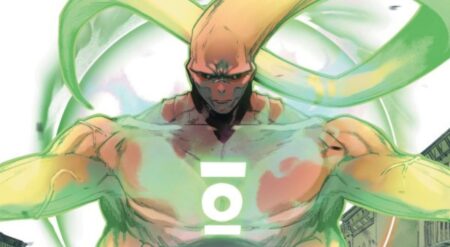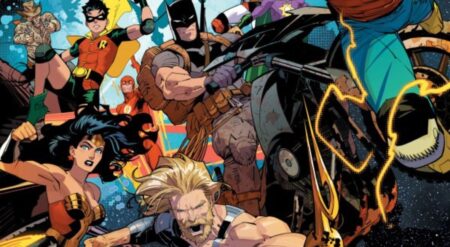Red Hood: The Hill #00 is published by DC Comics, written by Shawn Martinbrough, pencils by Tony Akins and Moritat, inks by Stefano Gaudiano, colors by Paul Mounts, and letters by Troy Peteri. Red Hood moves to an area of Gotham that has avoided much of the crime and violence. But The Hill will soon feel a crime wave itself.
This is a double-sized introduction to this region of Gotham. A few miles away from the main city, this is a location untarnished by darkness, death, and mystery. The Hill is frequently neglected by writers, only appearing in a few series. Huge emphasis is placed on the area surviving the wrath of the Joker War. As Red Hood makes himself at home, other plot threads show that Gotham’s legacy follows him. Old friends help him settle in, but the curse of his family seeps into the neighborhood. Stepping out of the shadow of Batman still requires the use of the Red Hood at times.
The extended length of the issue allows the landscape and the story to expand, but the pace suffers as a result. It takes a long time to find a stride. With so many meetings between the characters, the action takes a backseat to the exposition. Seeds of several stories are planted. Factions and history provide the foundations for the story. The Hills has avoided superpowers and vigilantes for a long time, but that is about to change.
The characters in Red Hood: The Hill #00 are interesting. Especially true for the residents of The Hill, who have grown up away from a city filled with bats, Jokers, and other elements that destroy communities. When they have ventured to The Hill, it left scars. The focus of the characters on the Hill are two sisters, Dana and Denise Harlowe. Both are old friends of Jason Todd, and the women have very different views on what is happening in their neighborhood.
The crime in this prequel issue is brilliantly established, with places of interest and people to look out for. Those who idolize figures in the main part of Gotham are making their own plans. One of Batman’s old villains is borrowed. However, they are not integral to the real plot. Despite the cameos, those who call the Hill home drive the story. Dana and Denise represent the heart and the mod within the community.
As for the Red Hood himself, he struggles to assert and establish himself as the protagonist of the book. He has to be reactionary. So much is happening, and the emphasis is not on him, so The Red Hood has to be a vehicle of discovery. His connection to the Harlowes is the most important thing to understand in this early stage of the series. This starting issue does not require much more from him.
The art isn’t perfect, but it has personality. The Hill is quickly given its own identity and is separated from Gotham in its design. But it has different parts that scream California or Florida without really looking connected. Characters that have come from elsewhere are adapted to fit the fashion of the region and look amazing. The design seems to embody multiple Grand Theft Auto Games all in one, and there is a certain charm to that. The seedy clubs and gangsters appear out of time, left behind by the rest of Gotham. However, there are some issues with depth and perspective. Characters can sometimes look bigger than they should from the distance that they are, such as inside a building when the view is from outside the window.
There is a huge amount of fun within the art. The costumes are ridiculous, but there is a basis for it within the book itself. The villain idolizes those who came before him, and so his outfit reflects that. And the vehicle that the visitor from Gotham has is hysterical. It’s extremely cartoony, to the extent Adam West’s Batman would ask for it to be toned down. The fight scenes are filled with energy that brings the book to life.
The colors have to fight between that energy and the darkness that is beginning to flood that part of the city. The nightclubs and the streets are dark and gloomy, but there is a detail to the shades. In the daylight, there is a yellow tint to the pages, which infers humidity and heat in the area. But it is the abnormal and the introduction of Gotham’s influence that brings the brighter shades. Green and purple raise eyebrows, as The Hills had been spared from those for so many years. The lettering fits the personality of the comic.
Red Hood: The Hill #00 is the comic equivalent of an expansion DLC. A neglected part of Gotham has been opened up. With it comes new supporting casts and villains, using cameos from the main part of the city to prop them up and stir the pot. However, a consistent identity needs to be established. Throughout the book, the buildings and the streets adapt and change, and it can be detrimental to the sense of place. It needs to decide on one of those designs and build off of it instead of having so many different settings that are supposed to be the same.
Red Hood: The Hill #00 is available where comics are sold.
Red Hood: The Hill #00
TL;DR
Red Hood: The Hill #00 is the comic equivalent of an expansion DLC. A neglected part of Gotham has been opened up… However, a consistent identity needs to be established.







